Abstract
Improvisation is a hallmark of human creativity and serves a functional purpose in completing everyday tasks with novel resources. This is particularly exhibited in tool-using tasks: When the expected tool for a task is unavailable, humans often are able to replace the expected tool with an atypical one. As robots become more commonplace in human society, we will also expect them to become more skilled at using tools in order to accommodate unexpected variations of tool-using tasks. In order for robots to creatively adapt their use of tools to task variations in a manner similar to humans, they must identify tools that fulfill a set of task constraints that are essential to completing the task successfully yet are initially unknown to the robot. In this paper, we present a high-level process for tool improvisation (tool identification, evaluation, and adaptation), highlight the importance of tooltips in considering tool-task pairings, and describe a method of learning by correction in which the robot learns the constraints from feedback from a human teacher. We demonstrate the efficacy of the learning by correction method for both within-task and across-task transfer on a physical robot.
